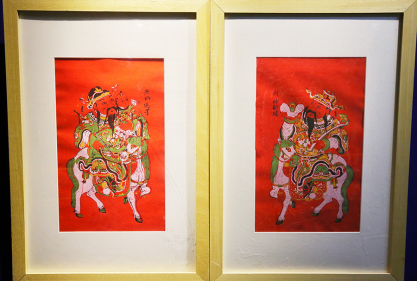
In China, there is a special kind of painting — Spring Festival pictures, or New Year pictures. Traditionally, people put up these colorful pictures on their doors and walls during the Spring Festival. Springn Festival pictures came into being with the activities for celebrating the traditional Chinese New Year, saying goodbye to the old year and welcoming the new, wishing for good luck, and keeping away bad things.
1.New Year pictures got the name because of ____________.
A a special picture character
B the time of putting them up
C where they first appeared
D a celebration activity
解析:选B。B细节理解题。根据第一段中的“Spring Festival pictures came into being with the activities for celebrating the traditional Chinese New Year”可知,年画是伴随着中国农历新年(春节)而产生的,是在春节的时候张贴的,故而叫做“年画”。故选B。
2.Which of the following was not a door god in the Tang Dynasty?
A Qin Shubao.
B Li Kui.
C Yuchi Gong.
D Zhong Kui.
解析:选B。B细节理解题。根据第二段中的“During the Tang Dynasty ... Qin Shubao and Yuchi Gong, were popular subjects for these pictures as door gods. Another common figure was Zhong Kui”可知,秦叔宝、尉迟恭和钟馗都是唐代的,李逵并未提及。故选B。
3.What does the underlined part “evil spirits” mean?
A Something special.
B Something interesting.
C Something bad.
D Something beautiful.
解析:选C。C词义猜测题。根据第二段划线部分前文的“protect against”和后文的“keep the family safe and healthy”可知年画都是用来驱“邪”纳吉的,即划线部分表示的是“不好的事物”。故选C。
4.New Year pictures at the beginning of the Qing Dynasty ________.
A were close to daily life
B paid no attention to society
C were of greater importance
D showed rich people’s colorful life
解析:选A。A推理判断题。根据倒数第二段中的“Many new themes showed the hopes and wishes of common people”可知,清初的年画更接地气,主题接近人们的日常生活。故选A。
5.In which part of a magazine can we read the passage?
A Life.
B Sports.
C Travel.
D Culture.
解析:选D。D推理判断题。根据全文内容可知,文章围绕中国独有的年画介绍展开,属于中国传统文化。故选D。